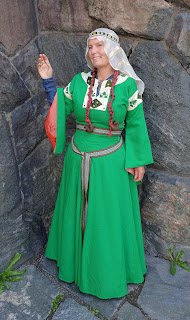Made in 2020
The pleated version is very French, though there are examples from Western Scandianvia (where you also have finds of fine pleated wool fabric from the period) too, but if you look at art from England, Germany and Eastern Scandianvia you see gowns which are not pleated, probably don't have a waist seam, and which do not have the exaggerated ruching at the sides, just a little gathering. So that was what I was going for.
The gown is made of rectangles and triangular gores, and all hand sewn with silk thread. The fabric is wool and the sleeves are lined with silk. I made a small exception to the the rectangular construction method and made the sides curve inward a little at the waist. I have a very big difference between bust, waist and hips (108- 84- 117 cm / c. 42-33-46 ") and something has to be done to accomodate that. Previously I have used my waist measurement as starting point and added gores at the bust and over the hips, but that puts the shoulder seams a little higher up than I want them, since the shoulder seam affects where you put the bicep trim if you, as I do, use it to cover up a seam.
I don't know if they did curve in their rectangles a little at the waist, but I don't think that it was an impossible solution if you were making clothes for someone shaped like me.
The gores makes it quite wide, it's almost 5 metres at the hem.
The gown is laced at the sides, which silk cords that I made with finger lucet. The silk yarn was dyed with madder by me and my friend Ragnhild 14 years ago.
The belt, which you see better in this images is a wool tablet woven belt that I custom ordered from Svetlonoska Tablet Weaving in Norway. It was very cheap considering that it is 4 cm wide and 3,5 metres long, it only cost 70 euros, and arrived in a week after ordering!
The embroidery is made on the cotton and silk mix that I used for Valeria's Eleonora di Toledo gown. I used "gold" thread, strips of "metal"wound around a thread, that I got on eBay from China, and silk yarn from Allehanda silk. The green lozenges are silk scraps. It would have been more period appropriate to fill those lozenges with split stitch, just like the hawthorn leaves in the white lozenges, but I was feeling a little lazy. One can discuss how period the pattern for the embroidery is, but at least I used period stitches, and I was inspired by borders in illumination from the 12th century, as well as from period embroidery, while also using motifs that mean something to me. The white flowers, which are mostly freshwater pearls (with a few glass beads when I ran out of the fresh water ones) are from my heraldic arms in the SCA, and the leaves match the flowers, which for me symbolizes the hawthorn flowers.
Close-up:
By this time one of my braids had gotten a little wonky, and since I didn't have access to a mirror I hadn't noticed. The left one is how both looked when I started.
I don't have this long hair, so what I did was to use clip-in hair that I already had and braid it together with my own hair. I think that I will try braiding in loose fake hair next time, as soon as I get hold of some. And use straighter fake hair, this is a little too curly.
Under layers
Under the wool gown I am wearing a supportive linen shift. Because of my G-cup boobs I need to make my supportive shifts with a seam just under the bust, and a short lacing in one side, to make it really tight there. It might have worked without these if my rib cage wasn't much wider at the bottom than just under the boobs - an affect of pregnancy while having chronic inflammation in the rib cage: the rib cage widens when pregnant and then normally it goes back (if not all the way back), but my rib cage has virtually no elasticity, so I am 12 cm wider at the bottom of the rib cage than under the bust, and seen from the the side it sticks out at c. 45 degree angle. So I need to make some accomodations.
Anyway, no photos of me in that shift right now. It is hand sewn from linen.
On top of it I have a linen chainse/under gown. I used linen diamond twill, which is debatable, but it was so pretty. The blue colour you can get with period dyeing techniques, but the dark red not so much. Just pretend that it's silk, will you? Or at least a linen cotton mix :)
Anyway, the gorgeous linen fabric is from Korps/Ravencraft. This is of course also entirely hand sewn, and here I used rectangular construction without any modfications. The neck opening is based on the Kragelund tunic, it's one of my favourites for this period.
Anyway, the gorgeous linen fabric is from Korps/Ravencraft. This is of course also entirely hand sewn, and here I used rectangular construction without any modfications. The neck opening is based on the Kragelund tunic, it's one of my favourites for this period.
Because I feel pretty in them I will add some photos where I am wearing my SCA baronial coronet too, even though it is c. 100 years later in style.








The coronet may be later in style, but it is nonetheless pretty with the outfit. So lucky our organisation doesn't care if we mix and match pretty stuff from different times!
SvaraRadera